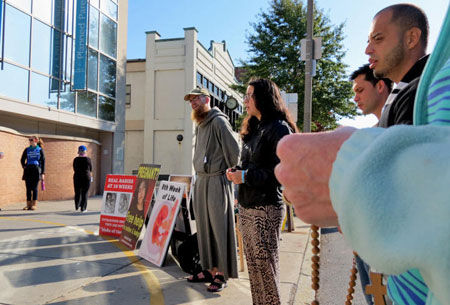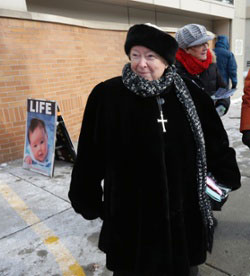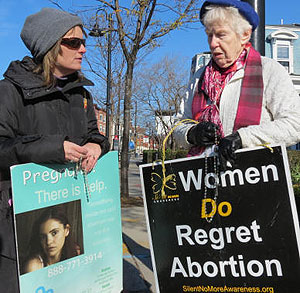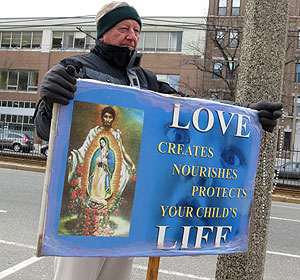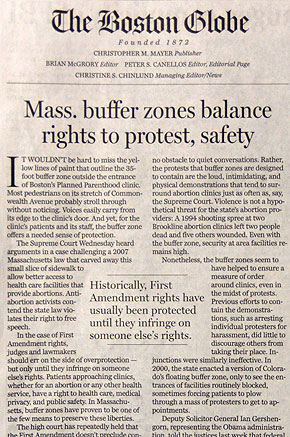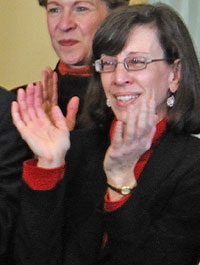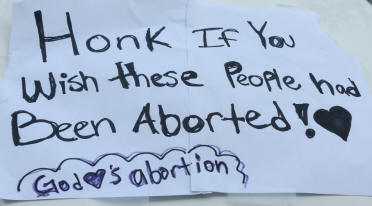 |
 |
Pro-family activism that makes a difference! | ||||
Massachusetts abortion clinic "buffer zone" law now before U.S. Supreme Court. Could likely be overturned, despite "big lie" strategy by activists.National implications. POSTED: January 23, 2014Could a big defeat for the national abortion lobby be coming? Last week the U.S. Supreme Court heard arguments on the case that could overturn the so-called "buffer zone" law in Massachusetts. Experts across the political spectrum are saying that the Court is very likely to strike it down -- affecting similar laws across the country. It would also be a victory for a group of unbelievably dedicated pro-life activists in one of the most pro-abortion states in America.
This case, McCullen v Coakley, has generated a lot of high-profile emotion among the pro-abortion Left. After the Court heard the arguments the case made the front pages of the New York Times, the Wall Street Journal, and the Boston Globe. The Massachusetts buffer zone law requires people with a pro-life message to stay at least 35 feet from the entrance of an abortion clinic, even if that includes a public sidewalk or street. But pro-abortion people affiliated with the abortion clinics can go in as close as they want. The law is the Massachusetts liberal establishment's effort to silence the opposition at a critical point in a woman's decision whetherto abort her child. It allows one type of speech on a public sidewalk, but prohibits opposing speech. Thus it's considered a major First Amendment case. Montana and Colorado have both have statewide buffer zone laws, and many cities and towns across the country have passed municipal buffer zone laws similar to the Massachusetts law. Why the Massachusetts law was passedMore than anything else, pro-lifers in front of abortion clinics such as Operation Rescue in Boston (OR-Boston), run by Bill Cotter since the late 1980s, is the reason the buffer zone law in Massachusetts was passed. Several days a week throughout the year, pro-lifers conduct prayer vigils and informational counseling outside of abortion clinics in Boston, Brookline, Haverhill, Worcester, Springfield, and Attleborough. They don't let up. And they are very effective. Since 2003, OR-Boston has saved 875 babies from death through their counseling efforts. That is a breathtaking achievement. Most pro-family groups do very good work, but how many can say they actually save lives? Hundreds of people are walking this earth who would have faced a violent death in the womb had it not been for these people. And that's what makes OR-Boston's efforts so despised by the pro-abortion Left and the mainstream media.
There's no question that if there was no pro-life presence at these abortion clinics there would be no buffer zone law in Massachusetts. Like much of Operation Rescue around the country, OR-Boston is primarily Catholic. The people who undertake this mission tend to be deeply spiritual, tireless and dedicated people. Many, like 77-year-old Eleanor McCullen (lead plaintiff in the suit), have been doing this for decades in every season, in all kinds of weather.
History of the lawPrior to 2000, there were some attempts by the abortion lobby to pass a 25-foot buffer zone bill, but it was blocked by pro-lifers in the Legislature's leadership. In 2000 the US Supreme Court ruled 6-3 in the Hill v. Colorado case, upholding a Colorado law establishing an 8-foot "bubble" around abortion customers within 100 feet of the facility, from which pro-life counselors were banned. Shortly after that, the remaining pro-life leadership in the Legislature compromised under pressure from the abortion lobby and Massachusetts passed a law similar to Colorado's. But even that was not satisfactory for the abortion lobby. So in 2007 the Legislature, by then dominated by pro-abortion politicians, passed the current law banning any pro-life counselors from entering an area 35 feet from an abortion clinic entrance, demarcated by a bold painted line. Not surprisingly, the liberal federal courts have upheld the law, despite its obvious constitutional issues. However, the makeup of the Supreme Court has changed considerably since 2000 and it has agreed to revisit this. Many veteran court-watchers think that the current judges will likely reverse the position taken in the 2000 ruling and side with the plaintiffs. In addition, noted First Amendment experts across the political spectrum have said the Court got it wrong in 2000. As the New York Times described the situation: The Supreme Court's 2000 decision has been harshly criticized, including by prominent supporters of abortion rights.
Also fighting it in the Massachusetts LegislatureIn each of the last few legislative sessions, MassResistance has filed a bill to repeal the buffer zone law. The current bill is H1478. It was heard before the Judiciary Committee on July 9, 2013. It's still alive, but admittedly repealing it is an uphill fight on Beacon Hill. Defending the buffer zoneReading the broad news coverage of this case and the "PR campaign" surrounding it, one can quickly see why the Massachusetts buffer zone bill has continued to be supported despite its obvious constitutional problems, and why the lower courts have bowed down before it. The public and political support of the buffer zone law in Massachusetts has been extremely well crafted by Planned Parenthood the abortion lobby. To put it bluntly, this is a textbook case of how the lies of liberals, when repeated constantly, become institutionalized and virtually immune to challenge. Basically, the constitutional issues are pushed aside and instead the public is constantly told about the alleged necessity of stopping violence and vicious harassment directed at abortion facilities and the women coming there for abortions. That is the mantra that is repeated over and over again to the point that it has become accepted as if it were fact. The 1994 Salvi incidentVirtually the entire "buffer zone" PR strategy grows out of one incident nearly twenty years ago. On December 30, 1994, John C. Salvi III, a 22-year-old man who was not affiliated with any Massachusetts pro-life group, entered two Brookline abortion clinics with a gun and opened fire, killing a receptionist. He was subsequently diagnosed as a schizophrenic and claimed that "the Mafia and KKK" were out to get him. He stood trial and was convicted of murder in 1996. Later that year he committed suicide in prison. At the time it was a major media event in Boston, which obsessed over it for months from every angle. It generated a considerable amount of hysteria against all pro-lifers, and thus became seared into the collective psyche of the region. (Ironically, say the pro-life advocates, no one gets convicted for the violent murders that routinely take place inside the abortion clinics -- of the pre-born children.) Since then, Salvi's name has been continuously brought up by pro-abortion activists to psychologically connect him with the (often elderly) Catholic sidewalk counselors, who in fact had nothing to do with him. As Saul Alinsky would point out, never let a crisis go to waste! A strategy of dishonest scare tacticsThat false "guilt by association" has opened the door to the abortion lobby's unending dishonest but very effective scare tactics. It has leveraged the Salvi violence from two decades ago into a complete mischaracterization of all pro-life activists today. Any time the buffer zone law is discussed, the abortion lobby talks in emotional terms about intimidation, violence, and screaming that supposedly goes on in front of abortion clinics which women seeking abortions and the staff must endure. It's certainly enough to make a reasonable person who doesn't know the truth agree that something must be done. But it's all a lie. There is no documented evidence that any violence, assaults, harassment, etc., by pro-lifers has taken place. Nor has the pro-abortion lobby ever presented any actual evidence. There haven't been any arrests of pro-lifers for assault or similar harassment. As Bill Cotter points out, each abortion facility has numerous video cameras constantly trained on the pro-lifers outside. But they've never been able to come up with any video proving their claims against the OR-Boston people. Moreover, we've been told that police records show that the police consider the pro-lifers to be extremely well-behaved -- especially compared to Occupy Boston and the like. Such hostile behavior would actually be counter-productive for pro-lifers. Yes, they sometimes show graphic signs of aborted babies (which is the truth; they are dealing with murder and death, after all). But pro-lifers realize that a certain demeanor is necessary or they will not save any babies. The big lie: Some recent examplesNevertheless, the mainstream media continues to repeat the outrageous disinformation from the pro-abortion activists without any challenge whatsoever. Here are some recent quotes from newspaper articles about the U.S. Supreme Court case: Boston Globe 6/24/2013:
New York Times, 1-15-2014
There's plenty of harassment and intimidation -- against pro-lifers!On the other hand, there is plenty of harassment, intimidation, and occasional violence in front of abortion clinics that isn't ever covered in the media. It's directed at the pro-lifers -- by abortion supporters. Pro-lifers often get horrible, vulgar things screamed them, things thrown at them from cars, and occasionally even cars careening toward them. There's plenty of evidence of that. They are also treated badly by pro-abortion cops.
But the media is psychologically wrapped up in the myth of pro-life violence. Bill Cotter relates that a few years ago a Boston Herald columnist wrote about an ugly scene where an angry man at an abortion clinic was arrested and began kicking in the police car doors until he could be restrained. The Herald article portrayed him as a pro-life activist. But the Boston Police Department's police report said that the man was actually a companion of a Planned Parenthood customer, who had gotten into a heated argument with the Planned Parenthood staff. Court's decision months awayIt's expected that the Court's decision will come sometime in June. We'll stay on top of this. We sense a victory is in the works. |
| Top |
